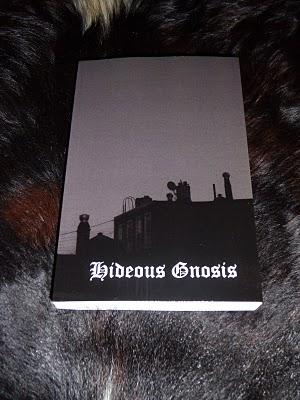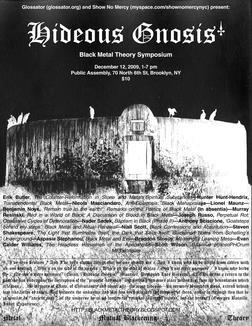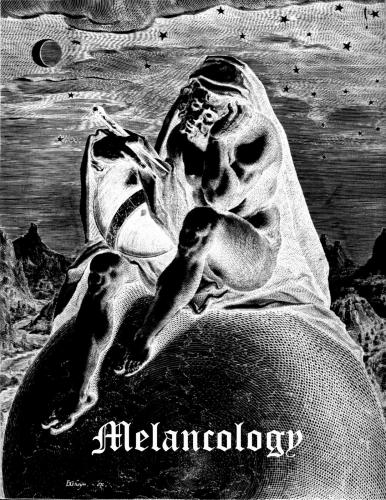http://www.miasma.org/uusinlehti/
Black metalin pelottava tieto
– Voiko black metalista puhua teoreettisesti?
Joonas Tanskanen
Kuvat: Nicola Masciandaro
”Black metalin soundi on kuultavissa teoriana.”
”Black metal on sisäisesti ristiriitainen, paradoksaalisesti yhtä aikaa ei mitään muuta ja kokonaan toinen kuin musiikki jota se on.”
”Odotan mielenkiinnolla herättääkö kirja kiinnostusta tutkijoissa, jotka eivät muuten ole kiinnostuneita black metalista.”
Mitä tapahtuu, kun kasa akateemikkoja laatii pinon tekstejä black metalista? Jos tahtoo tietää vastauksen, kannattaa hankkia käsiinsä kirja Hideous Gnosis.
Muutamia kuukausia sitten kirjamarkkinoille ilmestyi mielenkiintoinen black metalia käsittelevä opus Hideous Gnosis – Black Metal Theory Symposium. Nimensä mukaisesti kirja on syntynyt viime vuoden joulukuussa järjestetyn black metal -symposiumin myötä. Kirja dokumentoi symposiumissa vaihdettuja ajatuksia kolmentoista esseen ja muutamien muiden dokumenttien ja liitteiden voimin.
Otin yhteyttä kirjan toimittaneeseen, Brooklynin yliopistossa työskentelevään Nicola Masciandaroon ja pyysin häntä kertomaan tarkemmin kirjasta ja näkemyksistään black metalin teoriasta. Kristallisesta kirkkaudesta häntä ei voida syyttää, koska mies verhosi monet vastauksensa erikoiseen mystiikkaan.
Black metal -symposiumi
Hideous Gnosiksen tekstit muodostavat hajanaisen kokonaisuuden. Monesti tekstit lähestyvät black metalia hyvin erilaisista lähtökohdista. Aihetta tarkastellaan estetiikan, politiikan, symboliikan, maantieteellisyyden jne. kautta. Aina ei puhuta puhtaasti black metalista, kuten esimerkiksi Eugene Thackerin kirjan loppupuolella olevassa pitkässä esseessä Three Questions on Demonology, joka on mielenkiintoinen kirjoitus demonologian historiasta, demonien luonteesta ja siitä, miten demonit voidaan lopulta ymmärtää.
Yksi puute kirjassa on, ettei se pidä sisällään selvää johdantoa, jossa kerrottaisiin tarkemmin sen syntyhistoriasta. Siksi tahdonkin, että herra Masciandaro selvittää haastattelun aluksi black metal -symposiumin ja sen pohjalta syntyneen kirjan taustoja.
– Kirja perustuu black metalin teoriaa käsitelleeseen symposiumiin, jonka järjestäjänä olin viime vuonna. Hideous Gnosis on kokoelma tapahtumaan liittyneitä papereita ja dokumentteja. Se esittelee laajan otoksen näkökulmia ja käsittelee hyvin erilaisia aiheita aina telluurisesta ideologiasta apokalyptiseen humanismiin.
Masciandarolle black metal ja sen teoria on eräänlaista alkemiaa, prima materian eli ”mustan materian” esiin tuomista ja yhden tekemistä joksikin toiseksi.
– Symposiumin perusajatuksena oli synnyttää teoreettinen diskurssi, joka ei kohtele black metalia vain akateemisen ja teoreettisen ymmärryksen objektina tai fanityylisen tunnepohjaisen ihailun kohteena. Diskurssin lähtökohtana on pikemminkin sekoittaa raja black metalin ja teorian välillä. Viittaan tähän Black Metal Theory -blogissani seuraavin sanoin: ”Ei black metal, ei teoria, ei epä- black metal, ei epä-teoria, vaan black metal -teoria, teoreettinen metallin mustaksi maalaaminen, metallinen teorian mustaksi maalaaminen. Molemminpuolinen mustuminen”.
– Black metal -teorian etsiminen on jonkin kolmannen etsimistä, jotain joka syntyy black metalin ja teorian vuorovaikutuksesta. Eräässä mielessä se on jotain uutta, mutta toisaalta se on jonkin jo olemassa olevan (teorian ja black metalin) aktualisointia. Kirjan tarkoituksena on luoda jotain uutta tästä parivaljakosta. Näyttää siltä, että black metal on ajattelun muoto ja teoria on musiikin muoto selvästi havaittavassa paikassa. Se, että tämä paikka on vaikea ymmärtää sekä akateemikoille että metallifaneille, vain alleviivaa projektin tärkeyttä. Tätä aihetta käsitellään myös useissa kirjan teksteissä. Jos black metal on sotaa, niin black metal -teoria ei ole teoriaa sodasta, vaan teoriaa sotana. Se on taistelukenttä molemminpuolisille valtauksille musiikin ja filosofian välillä.
– Tämän lähtökohdan jälkeen projekti löysi pikku hiljaa oman auransa ja alkoi elämään omaa hämärää elämäänsä. Nimi Hideous Gnosis on lainattu Caïnan samannimisestä kappaleesta, joka ilmaisee jonkinlaisen negatiivisen ilmestyksen Jumalan katoamisesta tai kuolemasta: “I've seen demons / And I've been shown things that no-one should see / And I know why birds alight from cables with no-one beneath / Who's on the side of the angels / Who's on the side of Satan / God's not there anymore / I know why birds fly / No-one's there anymore”.
– Loppujen lopuksi minulle kirjassa tärkeintä oli sen tekeminen, eikä niinkään saavuttaa jokin selvä ja yhtenäinen lopputulos. Kirjan esseet puhukoot itse itsestään.
Black metaliin kätkeytyvää pelottavaa gnosista tai tietoa Masciandaro kuvailee hyvin hämärin sanoin:
– Black metalin gnosis on jotain, jota voi verrata David Lynchin elokuvassa Dyyni olevaan kojeeseen nimeltä Weirding Module. Black metal toimii kuin ylösalaisin käännetty ”vieraaksitekemiskone”. Weirding Module vahvistaa ajatuksen äänen tuhoisaksi voimaksi, mutta black metal kääntää antagonistisen energiansa ajatuksen ääneksi. Tämä ajatus ei ole käsite tai merkitys, vaan näkökulma johonkin joka säteilee tietynlaista pelkoa, siis kätkettyä gnosista. Tämä on kaiken sisäänsä sulkevaa pelkoa, se aistii kaikkialle tunkeutuvan omituisen tyynen ontologisen paniikin. Tämä kokemus edellyttää erilaisia mielikuvituksen muotoja ja spekulatiivisia näkyjä. Kuten näky, jossa koko maailmankaikkeus palaa, palaa ja palaa, ja kaikki oleva palaa siinä samalla, tai, kuten katkaistujen päiden valtava pyramidi, jonka on koonnut kosmisen yön mahtava valloittaja.
Antagonismin taide
Yksi kirjan mielenkiintoisimmista osuuksista on Benjamin Noysin kirjoittama Remain True to Earth, jossa Noys tarkastelee Peste Noiresta tutun Sale Faminen maailmankuvaa, jonka mies itse linjaa esteettispoliittiseksi oikeistolaismieliseksi radikalismiksi. Faminen ajatusten lukeminen on mielenkiintoista jo itsessään. Miehen ajattelun lähtökohtana on, että black metal ei voi koskaan olla olemassa abstraktissa muodossa, vaan aina tiettyyn paikkaan ja aikaan sidottuna. Tällainen alueellisuus on konkreettista ja todellista, poissa modernin maailman luomista, kapitalismin ja demokratian hämärtämistä abstrakteista käsitteistä. Esseessään Noys pyrkii selvittämään, missä mielessä black metalin estetiikka voi olla poliittista, vai onko black metal luonteeltaan liian paradoksaalinen, jotta sen yhteydessä voitaisiin puhua selvästä poliittisuudesta.
Hideous Gnosis -kirjan näkyvimpänä teemana voikin pitää tavoitetta valaista black metalin antagonistista mutta myös paradoksaalista luonnetta, ja samalla kysyä, miten black metalia voidaan määrittää ja onko se edes mahdollista. Antagonismia on vaikea purkaa teoriaksi, koska silloin se menettää helposti antagonistisen luonteensa. Elinvoimainen vastakulttuuri on aina haltuun ottamatonta ja määrittelemätöntä. Sitä ei voi kahlita ulkopuolelta tuleviin määritelmiin.
Masciandaro pohtii ongelmaa myös omassa esseessään Anti-Cosmosis; hänelle black metal on antikosmos ja kaaos ja samalla selvän diskurssin vastakohta. Voidaanko tällöin siis edes puhua black metalin teoriasta? Onko teoria jotain joka invalidisoisi koko genren, jotain joka on vastakkaista koko genren luonteelle?
Masciandaro selvittää näkökantaansa:
– Uskon, että black metalin teoriasta puhuminen on samaan aikaan mahdollista, mutta myös mahdotonta. Tietenkin on oltava toisistaan eroavia teorioita siitä, mitä black metal on, ei vain siksi, että ihmisen luonteeseen kuuluu asioiden teoretisointi, vaan koska black metal on luonteeltaan vahvan teoreettista. Black metalilla on soundi, mutta tämä soundi on ainoastaan kuultavissa, kun korvasi täyttyvät black metalista; ei vain siksi, että black metalilla on vahva yleinen idea joka tekee siitä tunnistettavan, vaan ennen kaikkea koska soundi tuottaa teoreettisia näkemyksiä kuuntelijassa. Toisin sanoen black metalin soundi on kuultavissa teoriana. Tämä johtuu osin siitä, että black metal on musiikin muoto, jossa ero äänen ja merkityksen välillä on samaan aikaan voimakkaasti maksimoitu ja minimalisoitu.
– Black metal on sisäisesti immanentti, joka ylittää minkä tahansa merkityksen. Se on pure fucking metal, jotain joka valtaa mielesi ja sielusi. Toisaalta black metal on riippuvainen niistä ideoista, jotka määrittävät sitä. Black metal on sisäisesti ristiriitainen, paradoksaalisesti yhtä aikaa ei mitään muuta ja kokonaan toinen kuin musiikki jota se on. Kuunnellessa sitä kuullaan käsite, ei yksityiskohtainen ja systemaattinen, vaan revitty ja hajanainen, tavalla joka pitää sen elinvoimaisempana. Black metal kiduttaa ideaa, logosta, huutonsa äänellä se luo ilmestyksen, joka ylittää kaiken tiedon ja havainnot itsestään. Black metalin ideat eivät ole selvästi musiikin esiin tuotavissa. Voidaan sanoa, että black metal ei ole asia, vaan funktio joka asettaa ihmiset kammottavaan ja ekstaattiseen suhteeseen ajattelun ja olemassa olon ykseyden kanssa.
– On olemassa myös ihmisiä, jotka tahtovat tämän suhteen pysyvän yksityisenä ja yleisesti tiedostamattomana. Heidän mukaansa black metal, kuten todellinen rakkaus, on jotain josta ei voida eikä myöskään saa puhua, aivan kuten puhe rikkoisi tai saastuttaisi sen olemuksen. Eräässä mielessä he ovat oikeassa, sikäli kun he tukeutuvat välttämättömään eroon sen välillä, mitä voidaan sanoa ja mikä voidaan ainoastaan näyttää, ja syvällisemmin mikä voidaan nimetä ja mikä ei. Mutta suurimmaksi osaksi ihmiset ovat tätä mieltä, koska he ovat kapeakatseisia ja tavoittelevat egoistista ja materialistista hyötyä.
– Vastakohtaisesti tahdon löytää black metalille teorian, en selittämällä mitä black metal on tai olemalla asiantuntija, joka tahtoo paljastaa sen salaisuudet, vaan haluan mieluummin nähdä black metalin vahvistavana taiteena ja ennen kaikkea sekoittaa eroa black metalin ja teorian välillä.
Uusi vastaan Vanha manner
Kirjassa on paljon keskustelua eurooppalaisen ja pohjoisamerikkalaisen black metalin erosta sekä toisen aallon skandinaavisen black metalin ja 2000-luvun black metalin suhteesta. Itse laitoin lukijana merkille sen, että kirjoittajien näkökulmat ovat useissa kirjan teksteissä hyvin Amerikka-keskeisiä.
Hunter Hunt-Hendrix jakaa esseessään Transcendental Black Metal black metalin kahteen kehitysjaksoon kuvaillen molempia hyvin nietzscheläisin käsittein. Ensin oli hyperborean black metal, jolla hän tarkoittaa skandinaavista black metalia. Sitä hallitsi blastbeat ja se edustaa kuolemaa ja negatiivista surkastumista. Toinen, ja hänen mukaansa kehittyneempi taso on transcendental black metal, jolla hän kutsuu Amerikan mantereella syntynyttä uudempaa black metal -aaltoa. Transsendentaalia black metalia hallitsee ”burstbeat” ja se edustaa elämää ja liikakasvua vastakohtana surkastumiselle. Se tahtoo muuttaa nihilismin affirmaatioksi, antaa black metalille uuden kehittyneemmän muodon. Transsendentaali black metal on jatkuvaa intensiteettiä, burstbeat ei koskaan saavu minnekään, se on aina vain melkein perillä, kun taas blastbeat on muuttumaton, vailla loppua, alkua tai dynamiikkaa. Transsendentaalinen black metal vahvistaa elämää ja myöntää elämän, se johtaa jatkuvaan kasvuun, ei staattisuuteen ja surkastumiseen.
Vanhan ja Uuden mantereen eroja setvitään myös Brandon Stosuyon kokoamassa keskustelussa Meaningful Leaning Mess, jossa useat tunnetut amerikkalaiset black metal -aktiivit keskustelevat oman mantereensa musiikista ja siitä, mitä tarkoitetaan käsitteellä USBM ja onko se edes relevantti käsite.
Masciandaro esittää oman näkemyksensä mantereiden välisistä eroista:
– Oma historiallinen käsitykseni genrestä ei ole kaikenkattava. Tämä näyttää olevan hyvin amerikkalainen piirre – heikko historiakäsitys, ymmärryksen puute kronologisista välttämättömyyksistä, kohtuuton ja naiivi tunne omaan napaan keskittyneistä oikeuksista… – joten en tiedä osaanko täysin vastata kysymykseen.
– Pohjoisamerikkalainen black metal on vahvan synkreettistä. Amerikkalaiset metallistit näyttävät etsivän enemmän harmoniaa kuin ristiriitaa. Jos eurooppalaisen black metalin tavoitteet ovat antikirkollisia ja fasistisia, niin amerikkalainen black metal tavoittelee spiritualiteettia ja epäpoliittisuutta, tavoite joka näyttää johtaneen selvästi merkille pantavaan isolationismiin ja lukuisten sooloartistien, kuten Judas Iscariot, Leviathan, Sapthuran, Xasthur ja Woe, esiintuloon. Tämä on hyvin karkea yleistys ja toivotan kaikki vasta-argumentit tervetulleiksi.
– Uskon, että tällä hetkellä on olemassa virtaus kohti uudenlaista yhteisöllisyyttä ja uudenlaisia tapahtumia: halu muuttaa black metalia viihteenä. Mahtava Gathering of Shadows -tapahtuma, joka järjestettiin Kalliovuorten metsissä, on iskevä esimerkki esoteerisesta ”punaniskamystiikasta”. Amerikasta löytyy myös taiteellisia urbaaneja tapahtumia, kuten Woldin äskettäinen esiintyminen Mathew Barneyn varastostudiolla jossa keikkaa edelsi painiottelu ja nietzscheläinen saarna.
Millaiseen kontekstiin sitten asettaisit black metalin osana taidemaailmaa?
– Black metal on moniulotteinen taidemuoto, joka pitää sisällään musiikkia, kuvia, sanoja, sosiaalisia rituaaleja ja niin edespäin. Se ei ole vain musiikkia, vaan taidetta yleensä. Se sopii moneen kontekstiin samanaikaisesti, eikä mielestäni tarvitse selvää kategorisointia tähän tai tuohon luokkaan. Black metal on taidetta, mutta sen merkitys taidemaailmassa (jota yleensä hallitsevat galleriat, kuraattorit, keräilijät ja kriitikot) syntyy siitä, että se on osa populaarimusiikkia jota ihmiset tuottavat ja kuluttavat suhteellisen itsenäisesti suhteessa taloudellisiin ja sosiaalisiin suhteisiinsa. Uskon, että black metalilla on taidemaailmalle paljon annettavaa dekadenttisen askeettisena taiteena. Se tarjoaa jonkinlaisen ääniesteettisen itsekidutuksen muodon, jonka kuuntelija voi omaksua ilman tartuntavaaraa.
Älykäs ja para-akateeminen
Kuten yllä on jo mainittu, kirja on kerännyt sekä ylistyssanoja että vahvaa kritiikkiä osakseen. Masciandarolle negatiivinenkin kritiikki on kuitenkin osa projektia.
– Kirja on kerännyt monia kehuvia ja asiantuntevia arvosteluja (katsokaa blogistani). Symposiumi sai negatiivista palautetta internetissä jo ennen kuin sitä oli edes järjestetty, ja kuten jo sanoin, tämä seikka on filosofisesti hyvin mielenkiintoinen. Suurin osa negatiivisesta keskustelusta on julkaistu kirjan lopussa liitteenä. Suurimmaksi osaksi negatiivinen palaute on kuitenkin ollut vain tiettyjen ihmisten itsetärkeilyä ja valtavaa energian tuhlausta. Tämän energian ihmiset olisivat voineet käyttää johonkin paljon kehittävämpiin asioihin. Palautteen voi jakaa yleisesti neljään luokkaan: välitön rakkaus, suora viha, epämääräinen ”se kuulostaa hyvältä” -asenne ja täysi tietämättömyys.
– Odotan mielenkiinnolla herättääkö kirja kiinnostusta tutkijoissa, jotka eivät muuten ole kiinnostuneita black metalista. Kirja on älykäs, mutta ei täysin akateeminen, paremminkin para-akateeminen.
Uusi black metal -symposiumi on luvassa jälleen vuoden 2011 alussa. Masciandaro toivoo tapahtumasta jokavuotista perinnettä.
– Seuraava symposiumi järjestetään Lontoossa 13. päivä tammikuuta. Se kantaa nimeä Melancology. Tarkemman kuvauksen melancologian ekologisesta ja luontoon liittyvästä käsitteestä voi lukea internetistä. Symposiumin järjestäjinä toimivat Scott Wilson ja Niall Scott ja se pitää sisällään Reza Negarestanin luennon. Tapahtumassa esiintyy Abgott. Myös tästä symposiumista tullaan kokoamaan ja julkaisemaan kirja. Nyt kun black metalin teorian ensimmäiset siemenet on istutettu, uskon seuraavan tapahtuman olevan edellistä suurempi.
– Toivon, että black metal -symposiumi tulee jatkumaan jokavuotisena talvitapahtumana, joka järjestetään eri paikoissa ja eri ihmisten toimesta. Tämä olisi käytännöllisin tapa harjoittaa älyllistä työtä ja se olisi paljon avoimempaa ja joustavampaa kuin jonkin järjestön tai julkaisun perustaminen. Glossator-lehdestä (glossator.org), jota olen mukana toimittamassa, on tulossa vuonna 2012 erikoisjulkaisu, jossa on 17 puheenvuoroa black metalin merkkiteoksista. Se tulee olemaan mahtava.













